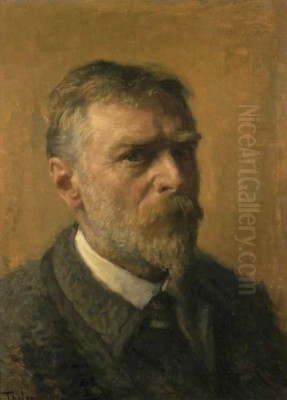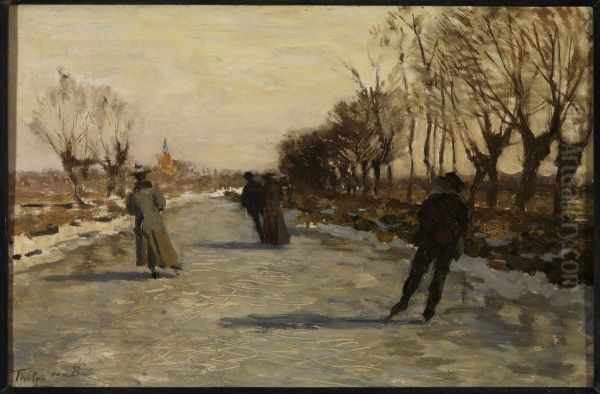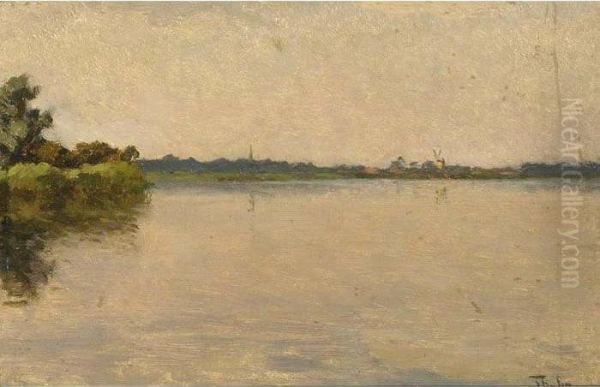
Willem Bastiaan Tholen stands as a significant figure in Dutch art history, bridging the late 19th-century traditions of the Hague School with the burgeoning influences of Impressionism. Born in Amsterdam on February 13, 1860, and passing away in The Hague on December 5, 1931, Tholen dedicated his life to capturing the unique atmosphere and scenery of the Netherlands. He was not only a painter but also a skilled draughtsman and etcher, leaving behind a rich legacy of works celebrated for their sensitivity to light, intimate portrayal of daily life, and deep connection to the Dutch landscape.
Tholen's artistic journey began in a supportive environment, as he hailed from a family with artistic inclinations. Although born in the bustling capital, his formative years were spent in the more tranquil setting of Kampen, a historic town situated on the Zuiderzee (now the IJsselmeer). This early exposure to the picturesque waterways, traditional boats, and expansive skies of the region profoundly shaped his artistic vision and provided recurring themes throughout his career. The landscapes around Kampen became his first muse, instilling in him a lifelong fascination with water, reflections, and the subtle interplay of light and atmosphere.
Early Training and Influences
Recognizing his talent, Tholen pursued formal art education. He initially studied at the National Academy of Visual Arts (Rijksakademie van Beeldende Kunsten) in Amsterdam, a prestigious institution that trained many prominent Dutch artists. Here, he honed his technical skills in drawing and painting. Following his time in Amsterdam, he spent a period at the Polytechnic School in Delft, where he studied drawing for a year. This structured education provided him with a solid foundation upon which he would build his distinctive style.
During his studies and early career, Tholen formed connections with other aspiring artists who would become notable figures in Dutch art. Among his contemporaries at the Rijksakademie were artists who would later be associated with various movements, including the second generation of the Hague School and Amsterdam Impressionism. These early interactions and shared educational experiences fostered a sense of camaraderie and artistic dialogue that was characteristic of the era.

A pivotal relationship in Tholen's early development was his friendship and collaboration with Paul Joseph Constantin Gabriël (1828-1903). Gabriël, an established landscape painter associated with the Hague School but known for his somewhat brighter palette compared to its early masters, became a mentor figure to the younger Tholen around 1880. They frequently embarked on sketching expeditions together, particularly exploring the polder landscapes and waterways near Kampen and Giethoorn.
Their collaboration was intensive; they would set up their easels side-by-side, capturing the same scenes from slightly different perspectives. Sometimes, they even depicted each other working outdoors. This close artistic partnership was mutually beneficial, allowing for an exchange of ideas and techniques. Gabriël's influence likely encouraged Tholen's focus on capturing the specific light and atmospheric conditions of the Dutch landscape, while Tholen's youthful energy may have invigorated Gabriël. A series of oil sketches from this period, many initially unsold, served as valuable source material for later, more finished studio paintings by both artists.
The Hague School Context
Willem Bastiaan Tholen is often situated within the context of the Hague School, particularly its later phase or "second generation." The Hague School, flourishing roughly between 1860 and 1890, was characterized by its realistic portrayal of Dutch landscapes and peasant life, often rendered in moody, atmospheric tones. Key figures of the first generation included Jozef Israëls, Jacob Maris, Willem Maris, Anton Mauve, and Hendrik Willem Mesdag. They sought to capture the unadorned beauty of the Dutch countryside and coast, emphasizing atmosphere over precise detail.
While Tholen shared the Hague School's dedication to depicting Dutch scenery and its focus on light and atmosphere, his work often displayed a brighter palette and a more distinct, sometimes looser brushstroke than the archetypal grey tones associated with the early masters. He belonged to a group of younger artists, including figures like Willem de Zwart and George Hendrik Breitner (though Breitner is more strongly associated with Amsterdam Impressionism), who absorbed the lessons of the Hague School but pushed towards new directions.
Tholen's landscapes, while realistic, often possess a clarity and luminosity that distinguishes them. He was less focused on the melancholic or socio-realistic aspects seen in some Hague School works (like those of Jozef Israëls) and more attuned to the picturesque qualities of everyday life and the transient effects of light on water and land. His connection to the Hague School is undeniable, particularly in his subject matter and observational approach, but his evolving style also aligned him with the emerging Impressionist tendencies in the Netherlands.
Amsterdam Impressionism and Urban Scenes

As Tholen's career progressed, his style evolved, incorporating elements associated with Impressionism, particularly the branch that flourished in Amsterdam. Amsterdam Impressionism, spearheaded by artists like George Hendrik Breitner and Isaac Israëls (son of Jozef Israëls), differed from the Hague School primarily in its focus on modern urban life – bustling streets, canals, cafes, and the dynamic energy of the city. These artists often employed bolder colors and more vigorous brushwork to capture fleeting moments.
While Tholen remained deeply connected to rural and waterside landscapes, he did not shy away from urban subjects. He painted views of The Hague, where he primarily lived and worked later in his life, and occasionally depicted scenes in Amsterdam. His cityscapes, however, often retain a sense of tranquility compared to the more gritty realism of Breitner. Tholen seemed particularly drawn to the interplay of architecture, water, and light within the urban environment, such as canals reflecting buildings or bridges spanning waterways.
His use of looser brushwork and a lighter, more varied color palette, especially in capturing sunlight and reflections, aligns him with Impressionist principles. He masterfully rendered the effects of light filtering through trees, sparkling on water, or illuminating building facades. This sensitivity to optical effects, combined with his grounding in realistic observation, places him as a key figure within the broader movement of Dutch Impressionism, standing alongside contemporaries like Breitner, Isaac Israëls, and Willem Witsen.
Master of Water, Light, and Dutch Scenery
Tholen's most enduring contribution lies in his masterful depictions of the Dutch landscape, particularly scenes involving water. Canals, rivers, lakes, harbors, and the sea were constant sources of inspiration. He possessed an exceptional ability to capture the reflective quality of water, rendering the subtle shifts in color and tone caused by changing light and weather conditions. His skies are equally impressive, often vast and dynamic, playing a crucial role in establishing the mood of the painting.
Boats are a recurring motif in his work, ranging from humble fishing vessels and barges navigating canals to elegant yachts sailing on broader waters. Tholen depicted these boats not just as objects but as integral parts of the landscape and Dutch life, often showing them moored along canals, docked in harbors, or actively sailing. His paintings frequently evoke a sense of peacefulness and harmony between human activity and the natural environment. Works like Veerstraat in Oude Wetering with Moored Boats exemplify this intimate connection to Dutch waterways.
His exploration of Giethoorn is particularly noteworthy. Visiting the "Venice of the North" around 1880, Tholen was captivated by its unique landscape of canals, thatched-roof houses, and small bridges. He is often credited as one of the first prominent artists to extensively paint Giethoorn, effectively "discovering" it as a rich subject for art. His depictions helped popularize the village among artists and tourists alike, showcasing its idyllic charm and watery character.
Tholen's fascination with light extended to different seasons and times of day. He is particularly renowned for his winter scenes, capturing the crisp air, frozen canals, and the lively activity of skaters. These works often feature a brighter light and clearer atmosphere than his summer landscapes, showcasing his versatility in rendering diverse conditions.
Signature Works and Artistic Techniques
Several paintings stand out as representative of Tholen's oeuvre and artistic achievements. Skating (circa 1891), housed in the Kunstmuseum Den Haag, is a quintessential example of his winter scenes. It depicts figures enjoying themselves on a frozen expanse, rendered with lively brushwork and a keen eye for capturing movement and the cold, bright light of a winter's day. The composition effectively conveys the spaciousness of the landscape and the communal pleasure of skating.
Another celebrated winter painting is Ice Entertainment (circa 1905), located in the Museum Gouda. Similar to Skating, it captures the joy and activity on the ice, showcasing Tholen's ability to handle complex scenes with multiple figures while maintaining a cohesive atmosphere. His skill in depicting the texture of the ice, the reflections, and the varied postures of the skaters is evident. The Ice Skaters, found in the Kröller-Müller Museum, further emphasizes his interest in this theme, often using strong horizontal lines to convey the sweep of the frozen landscape.
Beyond winter scenes, his depictions of canals lined with trees, harbors filled with boats under expansive skies, and quiet village streets are equally characteristic. Tholen often worked outdoors, making sketches and studies directly from nature, which he would later develop into finished paintings in his studio. His technique involved careful observation combined with an increasingly free application of paint, allowing him to capture the essence of a scene without getting lost in minute detail. His brushwork could vary from relatively smooth passages to more broken, textured strokes, depending on the effect he wished to achieve.
Printmaking and Draughtsmanship
Tholen's artistic output was not limited to painting. He was also a proficient draughtsman and printmaker, particularly skilled in etching. His drawings often served as preparatory studies for paintings but also stand as independent works of art, showcasing his sensitivity of line and ability to capture form and atmosphere with minimal means. Charcoal, pencil, and watercolor were among his preferred drawing media.
As an etcher, Tholen revisited many of the themes found in his paintings – landscapes, waterscapes, boats, and city views. Etching allowed him to explore tonal contrasts and linear expression in a different way. His prints often possess an intimacy and directness, reflecting his deep understanding of the subjects he portrayed. His graphic work forms an important, though perhaps less widely known, part of his artistic legacy, demonstrating his versatility across different media.
Later Life and Continued Recognition
Tholen spent much of his later career living and working in The Hague. He occupied a house with a studio, known as the "Kanaalvilla," situated beside a canal, which provided him with constant inspiration right outside his window. He remained active as an artist until his death in 1931, continuing to paint the subjects he loved with undiminished skill and sensitivity. His style, while rooted in the traditions he inherited, remained fresh and responsive to the nuances of the Dutch environment.
Throughout his life and posthumously, Tholen's work has been consistently appreciated by collectors and the public. He was a member of prominent artist societies such as the Pulchri Studio in The Hague and Arti et Amicitiae in Amsterdam, participating in their exhibitions. His paintings were acquired by major Dutch museums during his lifetime and continue to be sought after. While perhaps not as revolutionary as some of his contemporaries who moved towards Symbolism (like Jan Toorop or Johan Thorn Prikker) or Post-Impressionism (like Vincent van Gogh, though largely working abroad), Tholen carved out a distinct and respected place in Dutch art.
Recent exhibitions have reaffirmed his importance. A major retrospective showcasing his paintings, drawings, and prints was held in 2019-2020, first at the Fondation Custodia in Paris and then at the Dordrechts Museum in the Netherlands. Titled "Willem Tholen: A Happy Nature," the exhibition highlighted the breadth of his work and his consistent ability to find beauty in the everyday Dutch world. His inclusion in a 2017 exhibition celebrating the 175th anniversary of the Pulchri Studio further cemented his status as a key figure associated with the Hague art scene.
Contemporaries and Artistic Circles
Tholen operated within a vibrant Dutch art world populated by diverse talents. Beyond his close ties with Gabriël and his position relative to Hague School figures (the Maris brothers, Mauve, Mesdag, Jozef Israëls) and Amsterdam Impressionists (Breitner, Isaac Israëls, Witsen), he was aware of broader European trends. While direct influence from French Impressionists like Claude Monet or Alfred Sisley is debated, the general shift towards capturing light and momentary effects was part of the international artistic climate.
He was also contemporary with the "Amsterdamse Joffers," a group of women artists primarily active in Amsterdam who gained recognition for their portraits, still lifes, and genre scenes. Figures like Lizzy Ansingh, Thérèse Schwartze, and Coba Ritsema were part of this circle, contributing significantly to the Dutch art scene around the turn of the century. While Tholen's primary focus differed, their activity reflects the richness and diversity of artistic practice during his time.
Some critics occasionally found Tholen's work perhaps too attached to naturalistic representation, lacking the bolder experimentation of more avant-garde movements. However, this perceived conservatism can also be seen as a strength – a steadfast dedication to capturing the specific beauty and character of the Netherlands with honesty and technical brilliance. His work offers a serene counterpoint to the often more turbulent or socially charged art of some contemporaries.
Legacy and Conclusion
Willem Bastiaan Tholen's legacy rests on his sensitive and luminous depictions of the Netherlands. He masterfully captured the unique interplay of water, light, and sky that defines the Dutch landscape. His work bridges the atmospheric realism of the Hague School with the brighter palette and looser brushwork of Impressionism, creating a style that is both traditional and fresh. His paintings of canals, harbors, winter scenes, and the village of Giethoorn remain iconic representations of Dutch life and scenery.
His ability to convey tranquility and harmony, even in scenes of activity like skating or sailing, gives his work an enduring appeal. He found beauty in the ordinary, elevating everyday scenes through his skillful handling of light and composition. As a painter, draughtsman, and etcher, Tholen demonstrated remarkable consistency and dedication throughout his long career.
Today, his works are held in high esteem in major Dutch museums, including the Kunstmuseum Den Haag, the Rijksmuseum Amsterdam, the Dordrechts Museum, the Museum Gouda, and the Kröller-Müller Museum, as well as in numerous private collections. Willem Bastiaan Tholen remains a beloved figure in Dutch art, celebrated for his quintessential portrayals of the landscapes and waterways that continue to define the visual identity of the Netherlands. His art offers a window onto a world observed with affection, skill, and a profound appreciation for the subtleties of light and atmosphere.